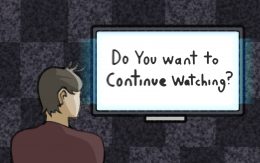
When I was in high school, during the steady popularity of Tumblr, I noticed a growing trend among my peers: depression and self-harm. People would repost images onto their Tumblr pages of teenagers, usually girls, with scars on their wrists from cutting as well as bruises or burns. These images are engrained in my mind.
Now, in addition to those memories, I can’t seem to get the images of “13 Reasons Why” — Netflix’s newest success — out of my mind.
The Selena Gomez-produced project was released on March 31, and was renewed for a second season on May 7. Fizziology, a company that analyzes social media traffic, reported that “13 Reasons Why” racked up more tweets in its first week than any other Netflix original show.
Needless to say, the target audience of the show is teenagers. The series’ premise is that Hannah Baker, a teenage girl, leaves 13 tapes to explain how 13 people led her to take her own life. Throughout the 13 episodes, Hannah and her peers are shown doing drugs, partying, bullying and being bullied. More shockingly, high-school students are graphically depicted raping, being raped and cutting themselves. Hannah’s suicide is shown in a gruesome single-take scene, where we are forced to watch her at every step.
Dr. Victor Schwartz, chief medical officer for the Jed Foundation, a suicide prevention nonprofit organization, said that multiple plot points of the show — in addition to the premise — could be harmful to young adults struggling with depression or suicidal thoughts.
“Sequences of terrible things happen to Hannah, and we don’t get a feel for her internalization until she kills herself,” Schwartz told NBC News. “None of that stuff is made clear because it’s focused on the horrible things people have done to her. The whole thing is an extended revenge fantasy.”
The show-runners can explain in a million interviews what their intent was behind the scenes. “We did want it to be painful to watch because we wanted it to be very clear that there is nothing, in any way, worthwhile about suicide,” said Brian Yorkey, screenwriter and creator, in a 30-minute Netflix special called “13 Reasons Why: Beyond the Reasons.” However, Yorkey can’t explain this meaning to every teenage girl struggling with depression; it seems quite dangerous that they couldn’t do as little as put up a screen showing information at the end of each episode, leading viewers to resources.
The same is true with the graphic depictions of rape that are seen in multiple episodes throughout the series. Other shows in our recent cultural conscience that grapple with these issues — “The Secret Life of the American Teenager,” “Degrassi,” “7th Heaven” — end these severe episodes with clips of the actors explaining that victims aren’t alone, that there are so many resources out there to help, that you are so very loved. This doesn’t happen at the end of each episode of “13 Reasons Why.” We are only told to begin the next episode, and continue learning about Hannah’s traumatic experiences.
In the beginning of each episode, a short warning for graphic content plays on the screen: “The following episode contains scenes that some viewers may find disturbing and/or may not be suitable for younger audiences, including graphic depictions of rape and sexual assault. Viewer discretion is advised.” The warning is similar for the final episode where Hannah’s suicide is shown graphically.
This is simply not enough. For a show like this, where individuals of any age can access the series on their laptops at any time, there is no way to regulate who is actually watching. I am not advocating for increased censorship or parental controls, but rather that content providers like Netflix should think twice before creating and distributing this type of media.
While the creators may portray these horrifying scenes in an attempt to “start a conversation” or to help viewers of the show through their struggles, they fail. Whatever their motivation may be, they exploit the audience that they claim to help, creating shock value in an attempt to keep viewers binge-watching their show. Watching a girl be sexually assaulted, watching a girl successfully kill herself — these aren’t things teenagers need to see.
“13 Reasons Why: Beyond the Reasons” automatically plays after the final episode of the season, and it works as more of a behind-the-scenes look at the glamorous actors than anything else. Hannah Baker is actually alive, and she’s a beautiful, bubbly Australian girl named Katherine. Bryce Walker is actually not a rapist, but an actor named Justin who spent two episodes on “Glee” dating Becky, a character with Down syndrome.
This is the tantamount problem with the show. With the end of Season 1, all of these troubled characters disappear into the void of fiction. But those who struggle in real life continue struggling, with no help of the characters they’ve just spent so many hours caring about.
Rape and suicide are not spectacles to entertain millions of people, and I am thankful that I’m 20 years old, and not still 16, when these images could have led me to a frightening place. I fear for the 16-year-olds who don’t have the privilege of being already out of high school when they binge-watch the show, and I fear for anyone struggling with mental illness who watches this series.
Rachel Greenspan is a junior majoring in English.


